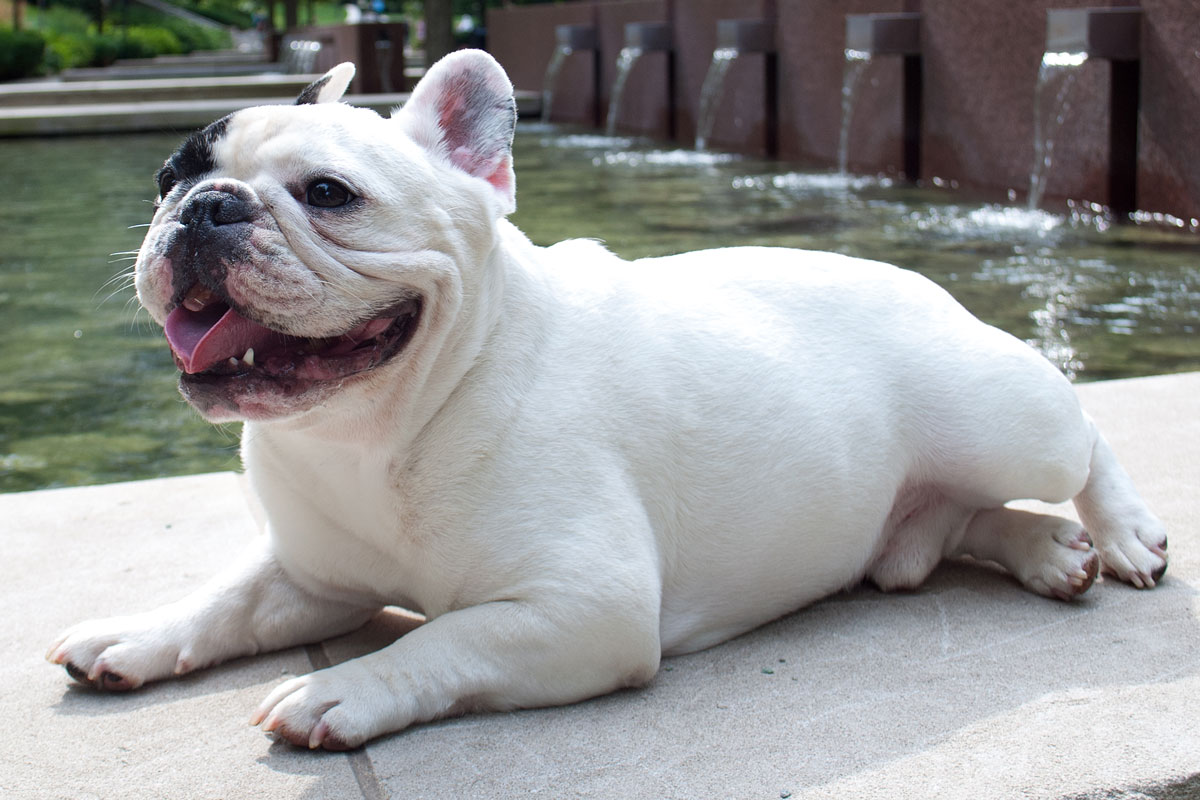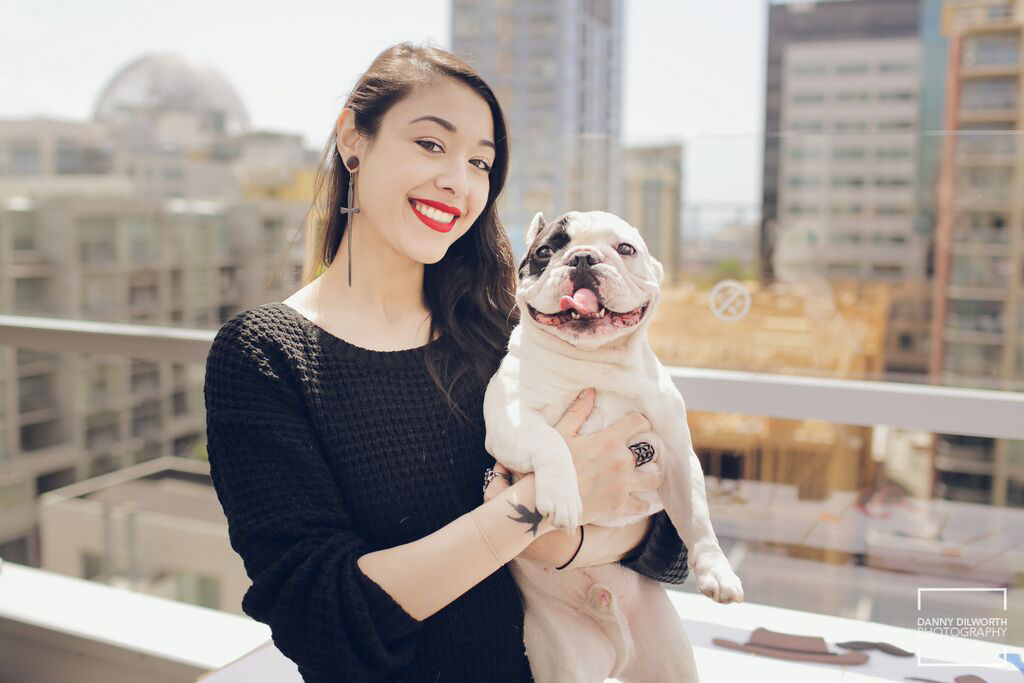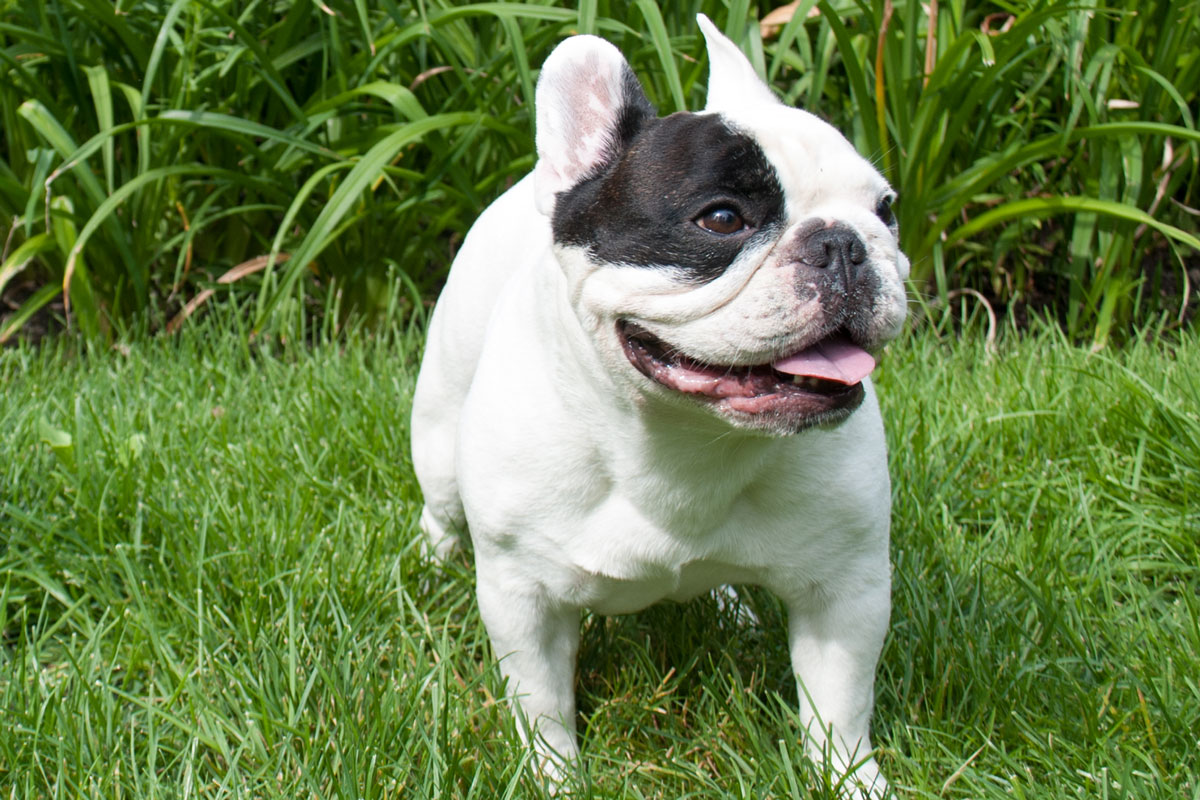Chicago’s latest social-media celebrity is four years old, licks everything in sight, and has more Facebook friends than you do.
Manny the Frenchie, a philanthropic French bulldog living in the West Loop, has spent his summer mingling with stars backstage at Lollapalooza, Mamby on the Beach, Spring Awakening, and Cirque du Soleil—all while raising more than $100,000 for charities such as ASPCA and the Special Olympics.
He chases bacon in an iPhone app and grins adorably on branded throw pillows. Snoop Dogg and Miguel Cotto are fans. Derrick Rose’s son, PJ, wears t-shirts plastered with his crumpled, spotted face.
And his owner, Amber Chavez, has the dream job of animal lovers everywhere: running her dog’s social media and philanthropy empire full-time.
“I’m like this crazy dog mom,” says the 32-year-old, who quit her job at the Peninsula Hotel spa two years ago when Manny’s circle of fans began to mushroom. Photos of Manny curling up in a bathroom sink went viral in 2013, leading Chavez and her boyfriend, Jon Huang, on a quest to see just how far they could take their dog’s newfound fame.

The couple had bought Manny at discount price from a breeder who deemed him unsellable—he was the runt of the litter and, at four and a half months, older than the puppies most buyers opt for. “I was like, ‘Let us see him and maybe we can even just give him a ride to the shelter,’ because the breeder was about to turn him over,” Chavez says. "But from the first second, he was so adorable. … You kind of just fall in love with his little face.”
Manny’s now-famous Instagram account, with 800,000 followers and counting, was originally launched as a way for Chavez and Huang to share snapshots of their bundle of joy with family. “He was like a firstborn; we were constantly taking photos and videos,” Chavez says. “I saw there were Instagrams for pets, and I thought it’d be pretty funny to start one for Manny.” But as other people started to take note, it turned into something of a challenge for the couple. 500 new followers one day, 1,000 the next. “My boyfriend started to get obsessed with it: ‘Let’s get more! Now I’m figuring out what we can do.’”
Today, Chavez is Manny’s full-time manager, maintaining social media profiles for Manny and his siblings—Frank, Leila, Filip and Liam—in collaboration with Huang and a few part-time employees. She also runs an online merchandise store, where you can pick up a Manny-branded T-shirt for $25. With more than 2 million followers between his Facebook, Instagram, and Twitter accounts, Manny has eclipsed several of Chicago’s human celebrities while barely lifting a paw.

“The pictures of him in the sink, ‘Frenchie talk’—those would get thousands and thousands of likes,” Chavez says. “Even though we ‘tried’ a little bit, it was all really organic and Manny just being hilarious.”
It was also social media strategy. Manny follows closely behind Lil Bub and Marnie in the ranks of pets who became so overwhelmingly Internet-famous that their owners turned them into full-fledged businesses. These A-listers are often popular due to their abnormalities, and Manny doesn’t have a lot of those—he’s a solidly cute, normal-looking Frenchie (“I’m a little biased, but yeah, he’s adorable,” Chavez says). For him to stand out among the likes of Princess Monster Truck and Yogurt the One-Eyed Chihuahua, Chavez and Huang paid close attention to the hashtags and posting times that would help Manny reel in the greatest number of viewers. It helped, too, that Frenchies have become wildly popular in recent years, jumping from number 54 in 2003 to number 9 in 2014 on the American Kennel Club's list of top dog breeds.
The couple also honed the image Manny is known for: that of the philanthropist pup. Through collaborating with American Apparel on a T-shirt for ASPCA and the French Bulldog Rescue Network, hosting fundraisers, and embarking on a U.S. tour benefiting local charities, Manny became the furry face of Instagram philanthropy. His 2015 tour continues August 22 in Denver (he’s already visited a half dozen cities this year, celebrating with famous-pet “cohosts” at each stop). Tickets to "PAWty" with Manny cost $30, with all proceeds going to Save-A-Vet and the Max Fund.
“We’ve always wanted to be able to help other dogs in need, especially Frenchies,” Chavez explains. “We donated to charities anyway, but once we started having this platform with Manny, we thought: How can we do this on a bigger scale?”

When I met Manny and his entrepreneurial mom at Lake Shore East Park, he was fresh off an appearance at Lollapalooza (where he wore ear protectors, of course). Within five minutes of chatting with Chavez, her pup was approached by two bright-eyed, stroller-pushing women. “I can’t believe it’s Manny,” they squealed, squatting down to take his picture. One of the fans showed Chavez a photo of her own French bulldog.
This isn’t a regular occurrence for Chavez—some of Manny’s followers don’t even realize he’s based in Chicago. But having an Internet-famous dog can take some getting used to, especially when it comes to defending it as her full-time job. Chavez declined to share Manny's total net worth, but said he's raised about $150,000 for charity over the course of his celebrity career.
“My parents are very old-school, traditional Mexican,” Chavez says. “So imagine me trying to explain in Spanish to my 70- and 80-year-old parents that I’m going to be working in social media for my dog. It was the funniest conversation. They’re still trying to wrap their minds around what’s happening.”
In today’s equal opportunity Internet economy, if your ferret or hedgehog doesn’t have a Web presence, you’re behind the times. As Patricia Carlin wrote in her book How to Make Your Cat an Internet Celebrity: A Guide to Financial Freedom, "The time to grab your slice of this furry pie is now." But you’ve got to be savvy about it.
“The Web has democratized content in general,” says Jonah Berger, a professor at the University of Pennsylvania's Wharton School of Business and author of Contagious: Why Things Catch On. “It used to be that big networks determined who became famous, but now someone with a video camera in their bedroom can become a celebrity if they can build an audience.”
Building an audience takes, more than anything, a keen awareness of human emotion. “Content that evokes high arousal emotions like excitement, humor, and inspiration, but also negative emotions like anger or anxiety, are more likely to be shared,” Berger explains. “To get your pet to go viral, craft content that evokes those emotions.”
For your dog to become as famous as Manny, Stephanie Edgerly, an audience insight professor at Northwestern University, recommends a carefully curated social media presence. “Not all social media sites are the same,” she warns. “I’m a big fan of figuring out what it is that you want to do, and then using the social media space that best allows that.” And if you’re going to use multiple platforms, don’t just copy and paste: “If people see your Facebook account is auto-populating from what you’re posting on Instagram, they’ll wonder why they’re following you on Facebook.”
While there is no perfect formula for pet fame, Chavez stresses a few necessary moves. Give your pet a voice (“Find something funny that they do”), be diligent about posting every day, and most importantly, listen to your friend. “Your pet has to be into it,” Chavez says. “Just like you can’t force a child to do anything, it’s the same with an animal. Manny works for treats, so he’s always happy.”
So what’s next for Manny and company?
“Eventually, we want to have our own charity,” Chavez says. “Though we’ve built a business on it, we don’t want this to be a business. We want it to be fun.”
You can catch Manny on tour this year and, in the future, at animal charity events around the city. If you meet him, by the way, be sure to bring bacon.



